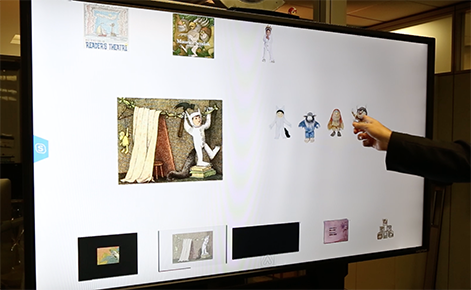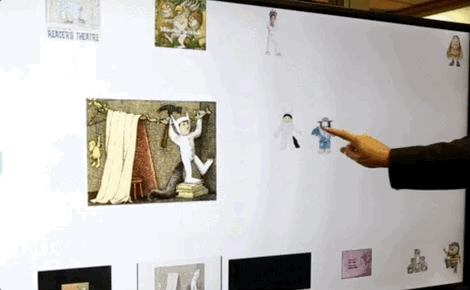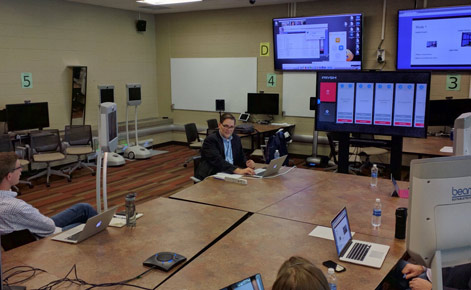A collaboration led by a Michigan State University researcher is bringing an innovative touchscreen technology into K-12 classrooms for the first time.

Professor Douglas Hartman is helping to introduce a teaching and learning tool that blends smartboards, tablets and laptops with 21st century learning. The large digital touchscreen—called a workspace, and created by Prysm, Inc., an international technology company—has unique classroom capabilities. For example, teachers can upload different types of content from a book (i.e., character images, videos, text excerpts or book pages, see below image) and utilize the functions to help increase learning opportunities. Educators can also write on the screen, rearrange elements or connect with communications services, such as Skype.
The Prysm workspace is being tested in two classrooms in Michigan’s North Branch Area Schools (NBAS).

Professor Doug Hartman showcases some of the uses of the touchscreen.
“It has potential far beyond smartboards,” said Hartman, who holds a joint appointment in the departments of Teacher Education and Counseling, Educational Psychology and Special Education. Educators and students alike are able to have multiple applications open, engage with educational games and more—all without opening and closing apps or toggling among windows.
The classroom opportunities and skilled teachers at NBAS were an ideal pair for a yearlong exploration into how such technology can impact learning, said Hartman. He has been working with the district for nearly 10 years to help make technology use in classrooms more teacher-designed and needs-based—something the Prysm technology will help grow.

Professor Doug Hartman
“We see the Prysm digital workspace as another tool that can provide remarkable possibilities for teaching and learning. It’s a blank canvas where teachers and students can design personalized learning,” added Hartman, who teaches courses on technology in the classroom for the Master of Arts in Teaching & Curriculum program.
“Work Smarter Together”
“This is the first engagement of the Prysm technology in a K-12 school,” said Brandon Fischer, vice president for research and development at Prysm. The company, with headquarters in California’s Silicon Valley, has long focused on creating digital products to make collaborating easier across disciplines, including sales, media and entertainment.
When the opportunity arose to work with MSU and bridge the gap into education, company leaders and university scholars agreed: There was “tremendous growth potential” for education and the company alike. Prysm loaned both screens to MSU and NBAS through summer 2018 to explore the idea.
Ever since, Fischer has been working closely with Hartman and educators in North Branch to ensure the screens are a perfect fit—and adapting them along the way.
“It’s an opportunity of joint exploration,” he continued. “Collaboratively, we’re looking at the platform to see how it can add value today, how to better engage students and what tweaks we can make to continue to add value, whether it is in a third grade classroom or higher education setting.”
The project aims to answer a series of questions in research and development, including:
- What are the learning progressions for the school community as they integrate the technology?
- What types of support are needed for the community to become fluent in its uses?
- What are the effects on teacher development, student learning and administrator effectiveness?
- What innovative uses are developed as teachers, students and school administrators experiment with and experience the affordances and constraints of the technology?
To answer these questions, Hartman, along with Professor John Bell and MSU doctoral students, are examining the teaching and learning capabilities of the workspace through the Design Studio at MSU. During the yearlong collaboration, they hope to better define how digital touchscreen and communication technologies can be integrated into teaching, learning and leading for teachers, students and administrators.
The NBAS classrooms are serving as a case study; MSU scholars are leading the research and development of the entire process.

Prysm, Inc. created a video to explore more about the new technology. Watch now.
Teaching with tech
Two elementary classrooms at NBAS were selected to participate in fall 2017. It didn’t take the teachers long to find a wide variety of uses and benefits of the screens—in and out of the classroom.
During class time, students are able to interact directly with the large touchscreen or use wireless school-issued tablets and laptops to connect to the screen. Teachers are able to experiment with new teaching methodologies.
The benefits of blending many digital technologies continues at home: Students and teachers are able to log in and connect to the screen’s capabilities from almost any device. This gives educators the ability to design lessons outside of the physical classroom, and gives students opportunities to engage with project work and lessons from anywhere.
With several months of utilizing the screen under her belt, third-grade teacher Kim Gormley says it is making learning more enjoyable.
“I’m having so much fun teaching with this technology,” she said. “I love seeing the excitement in the students’ faces when they are working with the technology.”
Gormley uses it in all areas with her elementary class. She’s led discussions of chapter books on the large screen, compared informational videos, modeled mathematical problem solving, facilitated an interactive activity, synthesized media sources on complex topics and much more.

Related links
WNEM featured some of the North Branch Area Schools students as they utilized the Prysm technology in the classroom. See how they created their own newscast.




